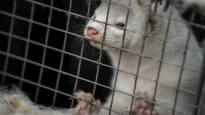Last October, workers at a mink farm in Carrala, near the Galician city of A Coruña, noticed that some of the mink’s muzzles were covered in blood. The minks had also started with hoiperre. In a week, their mortality increased up to thirty times compared to the shelter’s usual numbers.
The cause was sought with several tests, among other things, in case the COVID-19 corona pandemic had found its way to the mink farm, as had happened in Denmark during the first corona spring. The culprit was found in two minks: the avian influenza virus A(H5N1) found for the first time ever in farm minks.
Epidemics in Europe’s wild birds were worse than ever last year, and many mass cullings had to be done due to the infections that spread to poultry farms. In Carrala, the detection of the virus meant an immediate death sentence for 52,000 minks.
Eurosurveillance (you switch to another service)– magazine, according to a Spanish-Italian study, the H5N1 virus probably sneaked into the outdoor cage of the mink farm brought by a wild bird.
The finding is worrying. What makes it even worse is that the mutation apparently modified the virus in the shelter so that it was able to spread from mammal to mammal, the researchers conclude.
Minks can be a breeding ground for viruses
The viruses identified in the sequencing are in themselves a common branch in wild bird species and sometimes in poultry all over Northern Europe, but the detected T271A mutation may have public health implications, the researchers conclude.
T271A is a rare mutation but not a new one: it was also present in the swine flu virus that caused a human pandemic in 2009.
The bird flu virus is not susceptible to being transmitted directly from a bird to a human, but minks are susceptible to both bird and human flu viruses. That’s why minks may be the mixing bowl in which variants dangerous to humans are born, the researchers warn.
No similar changes have been observed in viruses transferred to humans from wild birds or poultry. However, new mutations have more and more opportunities to get close to people. In Spain alone, 37 epidemics were found in poultry last year.
“The fact that the virus is present in both poultry and wild birds has caused a ping-pong effect between them and enhanced the spread of the virus. We clung to the idea that we can control poultry infections and we have nothing to worry about. Now that the virus has established itself in wild birds, it is much more difficult to both contain it and predict where it will go next.”
Assistant Professor of Biology Nichola Hill, University of Massachusetts
Face masks became mandatory in Spanish mink farms after the Danish mink farm detected the coronavirus, and Carrala’s employees’ tests did not detect the bird flu virus even in a person with a runny nose.
Still, warning bells are ringing for people as well. We are playing with fire again, commented a Dutch professor of virology on social media Marion Koopmanswho was a member of the World Health Organization WHO team that traced the origin of COVID-19 to China.
The risk to humans from the pandemic, either from birds or via an intermediate host, is currently estimated to be very small, but still real.
In some cases, the virus was already one step closer to humans. An even bigger step would be if the virus adapted to multiply in pigs. Then the alarm bells would ring loudly, said the University of Helsinki’s assistant professor of threatening infectious diseases Tarja Sironen In an interview with last November.
– We do have influenza vaccines, but now influenza experts have to think about when there would be a need to produce bird flu vaccines. Are we still in time or is it too early? Should animals be vaccinated? Or people? There are big questions to be solved, Sironen said.
Bird flu has spread quickly to new areas. From Europe, Asia and Africa, the virus reached North America last year. Now it has already been reported from South America. On the coasts of Peru, 22,000 wild birds have died in a month, especially pelicans and brown-billed gulls.
At the beginning of January, Latin America’s first human bird flu infection was confirmed. An Ecuadorian child was hospitalized after contracting an infection from a chicken.
Pan American Sub-organization of WHO PAHO (you switch to another service) has emphasized the importance of surveillance, sampling and diagnostics in the new situation for both birds and people.
Bird flu has not been detected in Australia. If it spreads there too, birds that have developed in isolation from the rest of the world will be helpless in front of it, it shows at the University of Queensland (you are moving to another service) a study on black swans. The species is native only to Australia.
According to genetic research, black swans lack the immunity-related genes that in Europe give waterfowl protection from infectious diseases. Bird flu infection can kill a black swan even in just a couple of days, and the entire species would be threatened with destruction, Genome Biology (you move to another service) – a study published in the journal warns.
See more about the topic from Areena:
Sars, bird flu, influenza, corona. The COVID-19 pandemic showed that a virus can bring an entire society to a standstill. How has science fought past epidemics and what have we learned from them?
